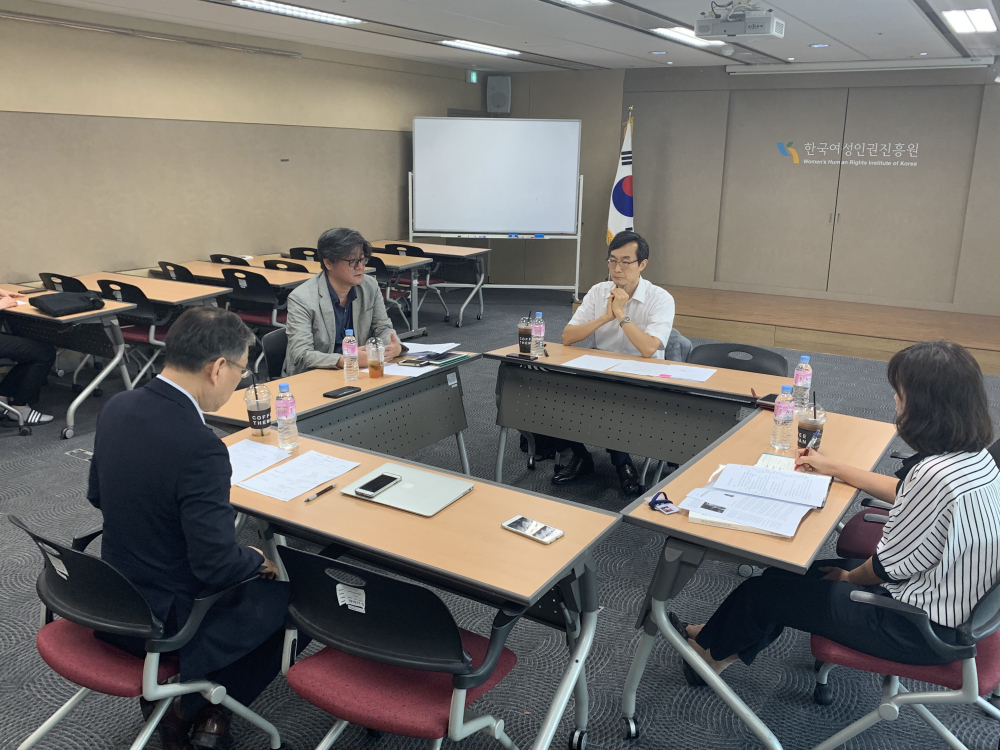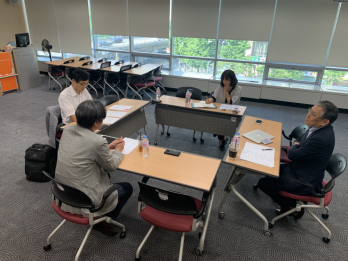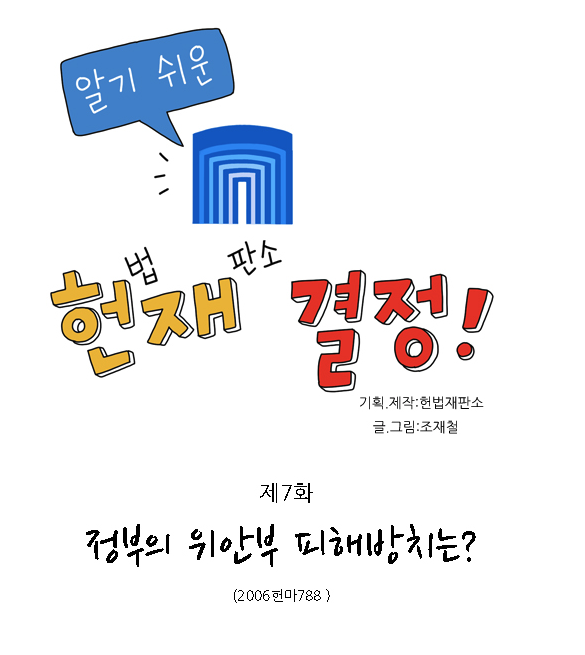The 2011 Constitutional Court’s Decision on the Unconstitutionality of Omission Marks the Turning Point for the “Comfort Women” Issue < part 1>
The Korea-Japan diplomatic problem spans both the past as well as the present. The diplomatic strife relating to the Japanese military “comfort women” issue has existed in the past, and will remain a challenge in the future as well. Then, what should we do to push Japan and Korea to continue the dialogue to clarify the truth in a responsible manner?
On June 5, 2019, Research Institute on Japanese Military Sexual Slavery (RIMSS), the Webzine <kyeol>, conducted a symposium that focused on these issues. This symposium was held before the current conflicts between Korea and Japan occurred, therefore, it does not include any content related to the recent issues, but it will give us a greater understanding of the diplomatic issues and the context surrounding the “comfort women” issue.
Part 1: The 2011 Constitutional Court’s Decision on the Unconstitutionality of Omission Marks the Turning Point for the “Comfort Women” Issue.
Part 2: What is the extent of the legal binding power of the “comfort women” agreement between Korea and Japan on December 28, 2015?
Part 3: To build responsible dialogue between the two countries to clarify the truth
Symposium Date: June 5, 2019
Moderator: Research Institute on Japanese Military Sexual Slavery
Panels: Nam Kijeong (Institute for Japanese Studies, Seoul National University)/ Cho Yanghyeon (Institute of Foreign Affairs and National Security)/ Cho Sihyeon (The Center of Historical Truth and Justice)
* Please note that the opinions of the panelists may be different from the official opinions of each affiliated institute and the Research Institute of Japanese Military Sexual Slavery(RIMSS).
The current diplomatic issue between Korea and Japan, and the international context surrounding the Japanese military “comfort women” issue <Part 1>
Q. The Japanese military “comfort women” is a familiar issue for Koreans. However, certain diplomatic issues and the subsequent developments surrounding the “comfort women” issue are quite difficult to follow. Of course, it has often been covered in the news, but the relating terminologies are difficult and there has been a variety of complex incidents. Could you please summarize the diplomatic events and context surrounding the Japanese military “comfort women” issues for the readers of the Webzine <kyeol>?
Nam Kijeong
The diplomatic issues relating to the “comfort women” history began to emerge in the early 1990s when the Japanese military ‘comfort women’ victims began to give their testimonies. At that time, the Korean government’s position was to raise the Japanese military “comfort women” issue to Japan, and then leave it to Japan to resolve it. Korea demanded Japan to take voluntary measures to take care of this issue. The Japanese government accepted it, and the Ministry of Foreign Affairs dispatched its officials to investigate the “comfort women” issue. As a result of the investigation, the Japanese government acknowledged that it would be appropriate for the Japanese government to respond to a certain degree on the “comfort women” issue, and the result of such a position was the Kono Statement of 1993. This was the first time the Japanese government clarified its position on the “comfort women” issue.
Subsequently, the Japanese government created the Asian Women’s Fund, in the form of a private fund. However, the Japanese government’s position was that the ‘legal issues had already been resolved (according to the 1965 Agreement on the Settlement of Problem concerning Property and Claims and the Economic Cooperation between the Republic of Korea and Japan (hereinafter ‘1965 Agreement’)), and that we are creating the Asian Women’s Fund due to the moral responsibility.’ It seemed and felt more like the good intention of the Japanese people, rather than an effort by the Japanese government to officially resolve the “comfort women” issue. Therefore, criticism began to grow within Korea against Japan for avoiding to take the full legal responsibility.
Consequently, a civic social movement began to unfold in Korea that demanded a proper resolution and the legal responsibility of the Japanese government for the “comfort women” issue. The game changer was the Decision on the Unconstitutionality of Omission from the Constitutional Court in 2011. With the decision of Korean Supreme Court, Korean government had no choice but to officially raise the Japanese military ‘comfort women’ issue to the Japanese government. This brought the “comfort women” issue to the front in the diplomatic relations between Korea and Japan. The Korean government requested a discussion pursuant to Article 3 of the 1965 Agreement related to the “comfort women” issue, but the Japanese government rejected such a request.
During the Park Geunhye administration, there were constant requests within Korea to resolve the Japanese military “comfort women” issue through diplomatic measures. The Park administration was taking a so-called one-track approach* on the Korea-Japan diplomatic relations, which meant the Japanese military “comfort women” issue was an obstacle that needed to be eliminated. As a result, the Agreement to Resolve the Issue of the Japanese military “comfort women” Slavery (hereinafter ‘2015 Agreement’), which we inevitably view as awfully insufficient, was made.
One-Track Approach: A method that treats the history-related issues and the normalization of Korea-Japan relationship as a single diplomatic issue.
Two-Track Approach: A method that separates the history-related issues and the normalization of the Korea-Japan relationship and responds to them respectively.
Q. The Decision on the Unconstitutionality of Omission from the Constitutional Court in 2011 and the 2015 Agreement are events that must be addressed when discussing the pending diplomatic issues surrounding the Japanese military “comfort women” issues. We will discuss them in more details later. Without diplomatic background or legal knowledge, the government’s policy on the Japanese military “comfort women” may seem to continuously shift back and forth. Could you point out the context for us to better understand the pending diplomatic issues?
Cho Yanghyeon
We need to consider a few points in order to explain how the 2015 Agreement originally came about. The first point is related to how each administration viewed the Japanese military “comfort women” issue. Since the Kim Young-sam administration in Korea, there was a strong trend towards a proactive approach to resolve the Japanese military “comfort women” issue. Of course, some administrations, such as that of Lee Myungbak, prioritized the trusting relationships between Korea-Japan over the resolution of the Japanese military “comfort women” issue.
Japan took a submissive attitude regarding the historical issues (as can be seen in the Kono Statement) up until the early 1990s when the Japanese military “comfort women” issue was first raised. However, starting with the Abe administration in 2006, Japan began to display conservative positions, so as to re-evaluate the Kono Statement, such as denying the forced conscription “comfort women”, etc. This marks the emergence of the historical revisionism. During the 30 years since the Japanese military “comfort women” issue has risen to the surface, the personal ideology of the administrations (both Korean and Japanese) and their leaders had substantial impact on how to respond to this issue.
The second point is the Korean Constitutional Court’s decision on the unconstitutionality of the government’s omission, rendered in 2011. This decision practically changed Korea’s policy on the Japanese military “comfort women” issue. Prior to this decision, the early Lee Myungbak administration represented that it would prioritize the practical interests with Japan, and the past history-related issues wouldn’t be on the agenda of the Ministry of Foreign Affairs. However, the government changed its position after the Constitutional Court’s decision on the unconstitutionality of the omission, and raised the Japanese military “comfort women” issue as an official diplomatic agenda with Japan.
Then the Kyoto summit was held in December 2011. Approximately 80% of the substance of the one-hour meeting was dedicated to the discussions on the Japanese military “comfort women” issue and the past history-related issues. During the Roh Moohyun administration in 2005, the Public-Private Joint Committee issued its conclusion that “the Japanese military “comfort women” issue hasn’t been resolved with the 1965 Agreement and the legal responsibility of the Japanese government remains,” but the issue was nearly buried due to Japan’s nonchalant response. Then the Constitutional Court’s groundbreaking decision served as the momentum to reverse the course. This judicial ruling had affected the foreign policy.
The third point focuses on the changes of the perspective on the Japanese military “comfort women” issue. Initially, people tended to think that the “comfort women” issue is a problem between the two parties (Korea and Japan). The reasoning behind it was that since Japan had committed illegal action of colonial domination, Korea may claim restitution and compensations from Japan, and Japan must investigate the truth relating to its past colonization and invasion. However, starting in the beginning of the 2000s, a perspective that it should be dealt with as part of the wartime sexual violence against women gained support, although this discussion had already been going on in the international community since the mid-90s, post-cold war era. Now it wasn’t just an issue limited to the past, but it was an ongoing, alive matter of the present. It began to be presented and raised as a women’s rights issue in the international community.
Cho Sihyeon
It is noteworthy that the Truth Commission on Forced Mobilization under the Japanese Imperialism, Republic of Korea began in 2004 pursuant to the Special Act on Forced Mobilization under the Japanese Imperialism. Moreover, last year, on October 30, 2018, the Korea’s Supreme Court rendered a decision that confirmed the rights of the victims of forced mobilization (by the Japanese government and companies) to claim compensation for the pain and suffering for the psychological damages, and ordered the Japanese perpetrator-companies to provide compensations for the victims. As you know, the victimization of the forced mobilization includes the Japanese military “comfort women”. In that sense, I believe it’s time to reassess how we approach to resolve the Japanese military “comfort women” issue, based on its connection to the forced mobilization issue.
Moreover, it is significant that the Japanese military “comfort women” issue has been examined in the international community. As you know, the “comfort women” issue first gained international attention when it was discussed as an issue of violence against women in the Sub-Commission on the Promotion and Protection of Human Rights under the UN Commission on Human Rights, immediately after the testimony of the victim, Kim Haksun, in 1991. It then became an issue during the evaluations of the human rights conditions in Korea and Japan under various human rights treaties signed by Korea and Japan. Recommendations have been – and are being – consistently and periodically adopted by the various UN bodies such as the UN Human Rights Committee, the Committee on the Elimination of Discrimination against Women (CEDAW), the Committee on the Elimination of Racial Discrimination (CERD), and the Committee Against Torture (CAT) to call for the Japanese government to fulfill its responsibility. UN’s various human rights bodies also have been commenting on the 2015 Agreement on the Japanese military ‘comfort women’ issue. This clearly indicates that this is an international issue. Moreover, a memorial-building movement for the “comfort women” victims has spread to all corners of the world. These international trends are continuing to this day.

Background and issues on the decision on the unconstitutionality of government’s omission by the Constitutional Court in 2011
The Constitutional Court’s decision on the unconstitutionality of government’s omission in 2011 has been selected as the most meaningful by the Koreans. As Cho Yanghyeon said, it was the trigger that changed the dynamics of the Japanese military “comfort women” issue. So, under what context did the Constitutional Court’s decision come about?
Cho Sihyeon
In 2000, the Women's International War Crimes Tribunal on Japan's Military Sexual Slavery found that the atrocities committed against the “comfort women” constitute crimes under the international law and establish that Japan as a state should be held responsible for them. However, the ruling didn’t lead to any changes in the attitude of the Japanese government, as it was a people’s tribunal. In Korea, the Act on the Support of Livelihood Stability was enacted to compensate the victims of the Japanese military “comfort women”, but this was a response of the Korean government (not the Japanese). Moreover, although a lump-sum was paid, it was still perceived as a humanitarian aid, rather than a proper form of compensation. Furthermore, despite considerable efforts to discover the truth regarding forced mobilization, it was quite difficult to hold the Japanese government to account.
This is when the civic society began to demand the Korean government to officially raise this issue to the Japanese government, as a diplomatic matter between the two countries. The demands from the activist organizations were as follows: A state is obligated to protect its people diplomatically, but the Korean government did not fulfill such obligation. Failing to fulfill such an obligation is an omission. The Korean government must exercise its right to diplomatically protect its people.
The trial took so long. The ruling finally came out five years later, and fortunately, it was a great decision. The decision basically reprimanded the Korean government because, while Korea and Japan continued to fight over the 1965 Agreement which is supposed to be resolved in a diplomatic means, the Korean government wasn’t making such diplomatic efforts when it comes to the “comfort women” issue.
The Lee Myungbak administration accepted this ruling and immediately requested the Japanese government to have a discussion. As the Constitutional Court’s decision was made on August 30, 2011, and the request for consultation with the Japanese government was made on September 15, it only took 15 days for the Korean government to take action. In any case, a great result came out of the Constitutional Court amidst series of negative events such as denial of the forced mobilization of “comfort women” after Abe’s first cabinet was formed. The Constitution Court recognized the same logic admitted at the Supreme Court in 2012, which was the first Supreme Court decision, granting compensations for damages against the Nippon Steel Corp. and the Mitsubishi Heavy Industries, Ltd. for the forced mobilization. The decision recognized that the colonization of Japan was illegal, and the forced mobilization under illegal occupation was an illegal and inhumane act; therefore, the Japanese companies must compensate for it.
The Constitutional Court held that the forced mobilization issue was not included in the 1965 Agreement, and that it was an issue outside it. Therefore, it said that the ‘Korean government has not waived the diplomatic protection.’ The two logics of the Constitutional Court are the same; one of which is that the Korean government must actively make every effort to resolve the issue, and the other is that the diplomatic protection is valid.
Nam Kijeong
The position of Korea’s Supreme Court in 2005 was that ‘there are issues that remain unresolved from the 1965 Agreement.’ To my recollection, I believe it demanded a response from the Korean government based on the decision that the Japanese military ‘comfort women’ issue must be resolved. My understanding of the decision was - even though it is a very complex issue – that the Court ordered the Korean government to resolve it because it had been sitting on this unresolved issue from the 1965 Agreement. It was not an issue of how to interpret the 1965 Agreement. It was the first ruling that specified the Korean government’s obligation to make every effort to resolve the issues outside of the 1965 Agreement. There was diplomatic protection that we did not waive in 1965, but there is also diplomatic protection that we did not exercise. My understanding of the Court’s decision was that the Korean government must exercise its diplomatic protection.
Cho Sihyeon
I think, ultimately, what diplomatic protection requires and what the Constitutional Court ruled can be understood under the same context. Diplomatic protection under the international law means that a state has an obligation to make an effort to resolve the issue when its citizen’s rights are violated while overseas. Since any matters that are subject to diplomatic protection typically occur overseas, diplomatic protection inherently involves a potential infringement of sovereignty and an interference in the domestic affairs; however, diplomatic protection exists because a state should be able to assist in protecting the rights of its people. A specific way to exercise the diplomatic protection is to request consultation, meaning a conversation. There may be a diplomatic negotiation, and depending on the circumstances, a resolution may be sought through international tribunals, such as an arbitration. Diplomatic protection may refer to various forms of diplomatic efforts. Of course, it’s not as if the Korean government has done nothing in this matter. It was simply that the Constitutional Court ordered the government to be more active.
https://www.ccourt.go.kr/cckhome/kor/ccourt/maindecision/maindecision.do
Related contents
-

-
What is the extent of the legal binding force of the Korea-Japan Agreement of December 28, 2015 on the “comfort women” issue?
-
<Part 2> Nam Kijeong (Institute for Japanese Studies, Seoul National University)/ Cho Yanghyeon (Institute of Foreign Affairs and National Security)/ Cho Sihyeon (The Center of Historical Truth and Justice)
-
What is the extent of the legal binding force of the Korea-Japan Agreement of December 28, 2015 on the “comfort women” issue?
-

-
To build responsible dialogue between the two countries to clarify the truth
-
<Part 3> Panel: Nam Kijeong (Institute for Japanese Studies, Seoul National University)/ Cho Yanghyeon (Institute of Foreign Affairs and National Security)/ Cho Sihyeon (The Center of Historical Truth and Justice)
-
To build responsible dialogue between the two countries to clarify the truth
-
Writer
Editorial Team of Webzine
-
Editorial Team of Webzine <Kyeol>
